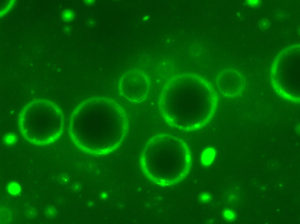A microfluidic sonication device for the production of coated microbubbles

The Oxford Team has developed a platform technology that could be used in a clinical setting to produce microbubbles employed as contrast agents in ultrasound imaging or as drug delivery vehicles. The technology also has other applications including foods, paints, biofuels and cosmetic products.
The use of microbubbles as contrast agents has been widely researched but it is well known that microbubbles manufactured using existing techniques suffer from poor stability, production rate and device lifetime. The Oxford technology combines the use of an ultrasonic device with a microfluidic channel to overcome the issues faced in producing bubbles with conventional emulsification techniques and standard microfluidics. Using this technology, microbubbles can be produced with very narrow size distributions and also with very high stability and high throughput.
Gas-filled microbubbles
Gas-filled microbubbles stabilised by a surfactant or polymer coating are routinely used in medical imaging as ultrasound contrast agents, being capable of enhancing ultrasound backscatter from blood by several orders of magnitude. Furthermore, the microbubble shell can be employed as a scaffold for transporting biologically active compounds or targeting agents in the circulation, which has opened the way for the use of microbubbles as vehicles in therapeutic applications such as drug delivery or gene therapy. However, the acoustic response and therefore the clinical utility of microbubbles are profoundly influenced by their physical characteristics, including size, size distribution, and the mechanical properties of the coating layer. Therefore, there is a need for a system which offers tighter control over microbubble properties to maximise their clinical effectiveness.
Manufacturer of microbubbles
For the majority of applications, microbubbles are currently fabricated using standard emulsification methods such as sonication which results in highly heterogeneous microbubble populations in terms of size, surface properties, and stability/dynamic response and loading of e.g. drugs for therapeutic applications. Over the past 10 years, microfluidic devices have been explored as an alternative but whilst these offer excellent control over microbubble size, they suffer from low production rates, short device life time, and poor control over microbubble surface properties.
Advantages of the Oxford system
Compared to conventional methods, the Oxford approach offers the advantage of higher control over the properties of the physical environment in which microbubble formation occurs, allowing for improved reproducibility between experiments and narrower microbubble size distribution. Furthermore, the parameters in the system can be finely adjusted in order to optimise the characteristics of the finished product, such as microbubble size, size distribution and concentration, and physical properties of the microbubble shell which are key determinants of microbubble stability and response to ultrasound.
Oxford University Innovation is looking to speak with parties interested in developing or licensing this technology. The technology is subject to a patent application.
about this technology

